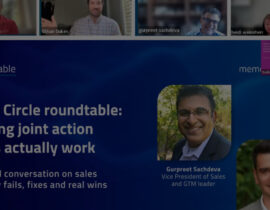The science behind winning sales calls: five proven techniques (backed by real data)
Every successful sales call is part art, part science. We’ve all been there: sometimes a call just clicks,while others feel like a slow grind. So what’s really making the difference?
After analyzing over 40,000 real-world prospecting calls, a researcher named Bitty Balducci (who is an Assistant Professor of Marketing at Washington State University) uncovered some pretty fascinating insights into what makes sales calls truly effective. Here, I’ll share five practical, proven techniques that emerged from the data—strategies you can use today to make your calls more engaging and productive.
Technique 1: future orientation
What it means Future orientation means clearly focusing the conversation on the future value your prospect will get from your solution. Instead of just highlighting past successes or current product features, you’re painting a clear picture of how your solution makes tomorrow better.
Why it works Turns out, prospects don’t care nearly as much about where you’ve been as they do about where you’re going to take them. Our research showed a clear link: sales reps who emphasized future benefits dramatically boosted their odds of positive outcomes.
How to implement
- Use future-focused phrases like “You’ll see…” or “We’ll help you achieve…”
- Paint a vivid, clear picture of your prospect’s improved future state.
- Always connect the next steps directly to specific future outcomes they care about.
Example: Instead of saying, “Our software has helped many companies,” say, “With our software, you’ll cut your reporting time in half starting next month.”
Technique 2: adaptive pace
What it means Adaptive pacing means adjusting your speaking speed to match—but stay slightly ahead of—your prospect’s natural pace. This subtle shift helps you maintain control and engagement throughout the call.
Why it works Think about a time when you’ve spoken with someone who talked painfully slow or frustratingly fast—it’s distracting! SDRs who matched the prospect’s pace (but were slightly faster) saw significantly improved engagement because the conversation felt natural yet energized.
How to implement
- Actively listen at the start to gauge your prospect’s natural speaking rhythm.
- Adjust your own speech slightly faster—enough to show enthusiasm without causing stress.
- Pay close attention throughout the call, adjusting pace if you sense a change.
Example: If your prospect speaks calmly, match their steady rhythm but inject just a bit more energy into your voice to keep things lively.
Technique 3: dynamic pitch
What it means Dynamic pitch is all about varying your intonation—moving your voice up and down naturally rather than speaking flatly. This signals genuine excitement and keeps your prospect engaged.
Why it works Nobody wants to talk to a robot, right? Monotone voices make us tune out quickly. But a naturally expressive voice signals authenticity, excitement, and involvement—sparking curiosity and maintaining attention.
How to implement
- Consciously practice changing your pitch to highlight important points.
- Use pauses and vocal emphasis strategically to capture attention.
- Regularly listen back to recordings of your calls to pinpoint areas where your delivery could use more life.
Example: When introducing a key benefit, pause slightly and emphasize it by changing your pitch: “Here’s the really exciting part…”
Technique 4: controlled positivity
What it means Controlled positivity involves consciously using optimistic and confident language, rather than being overly polite or tentative. This creates clarity and trust without sacrificing sincerity.
Why it works We’ve all experienced overly polite calls that sound scripted or fake—it creates distance. Clear, positive language builds rapport naturally, fostering genuine connection and trust.
How to implement
- Replace negative terms (“problem,” “issue,” “bad”) with neutral or positive alternatives (“opportunity,” “challenge,” “area to improve”).
- Stay action-oriented, focusing on possibilities rather than limitations.
- Balance enthusiasm with realism—be positive but don’t oversell.
Example: Instead of saying, “We know budgeting can be a real issue,” try, “Budgeting can be a great opportunity for us to help you optimize.”
Technique 5: active listening
What it means Active listening is genuinely tuning into your prospect, demonstrating your attention through paraphrasing, thoughtful questions, and immediate, relevant responses.
Why it works Prospects open up more when they feel heard. Interestingly, our analysis found successful SDRs didn’t necessarily speak less—they just used their speaking time differently, clearly demonstrating attentive listening.
How to implement
- Frequently paraphrase or summarize the prospect’s key points to confirm understanding.
- Ask thoughtful, open-ended questions inspired directly by what they’ve shared.
- Mirror your prospect’s language, picking up their exact words to deepen trust and connection.
Example: If a prospect mentions they’re struggling with efficiency, respond specifically: “When you say efficiency, do you mean reducing paperwork or speeding up workflows?”
The bottom line
By combining these five proven techniques—future orientation, adaptive pacing, dynamic pitch, controlled positivity, and active listening—you’re equipped with a research-backed toolkit for winning more calls. These aren’t theoretical concepts—they’re real skills that work in everyday calls. So, give them a shot in your next conversation. You might be surprised how quickly your results improve.
If you want to learn more, check out this podcast I did with Assistant Professor Bitty Balducci…really interesting findings!




